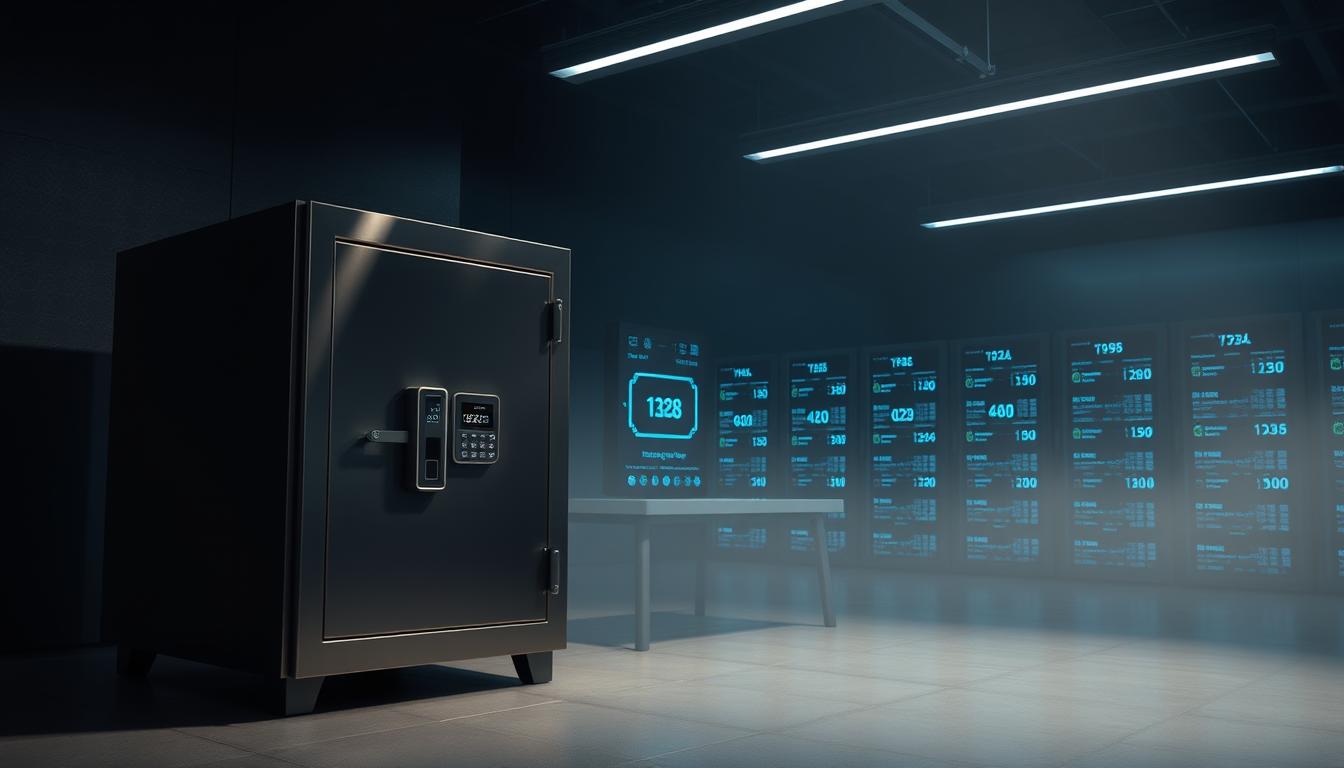Now Reading: NFT Art Storage: Best Practices for Safekeeping
- 01
NFT Art Storage: Best Practices for Safekeeping
NFT Art Storage: Best Practices for Safekeeping

Imagine owning a rare masterpiece worth millions. You’d secure it in climate-controlled vaults with round-the-clock surveillance. Today’s digital collectibles demand similar protection, with some tokens reaching valuations rivaling physical art at major auctions.

The market for blockchain-based collectibles exploded from $13.7 million to $2.5 billion in just one year. Landmark sales like Beeple’s $69 million piece at Christie’s prove these assets aren’t passing fads. Unlike physical art, these tokens can represent music, virtual real estate, or even proof of academic achievement.
Blockchain technology solves the age-old problem of verifying authenticity in digital spaces. Each token acts as an unforgeable certificate of ownership. Yet this innovation brings new challenges – how do you safeguard something that exists purely in digital form?
Key Takeaways
- Digital collectible valuations now compete with traditional art masterpieces
- Market growth exceeded 18,000% between 2020-2021
- Blockchain enables verifiable ownership of unique digital items
- Storage security impacts both financial value and long-term accessibility
- Protection strategies must evolve with emerging technologies
Understanding the Rise of NFTs and Their Digital Impact
A seismic change in how society values digital creations began with a single pixelated image. Kevin McCoy’s 2014 “Quantum” – a hypnotic octagon – became the blueprint for modern blockchain-based collectibles when it sold for $1.47 million years later. This early experiment revealed a truth: digital scarcity could create tangible worth.

From Underground Experiment to Mainstream Phenomenon
The technology powering unique tokens evolved quietly before exploding into public consciousness. Blockchain’s immutable ledgers solved a critical problem: proving true ownership of digital items. Unlike cryptocurrencies, these tokens can’t be replicated, making each one irreplaceable. Platforms like Ethereum gave developers tools to build verifiable digital marketplaces.
Economic Waves Reshape Creative Industries
Between 2021 and 2022, the market for blockchain-based items ballooned from $13.7 million to over $5 billion. Landmark sales shook traditional institutions – Beeple’s $69 million Christie’s auction proved digital works could rival physical masterpieces. Celebrities amplified the trend: Grimes earned $6 million for virtual creations, while Jack Dorsey’s first tweet fetched $2.5 million.
Three key drivers fuel this revolution:
- Provable scarcity through blockchain authentication
- New revenue models for creators via smart contracts
- Expansion into gaming, virtual real estate, and identity systems
As virtual worlds mature, these tokens are becoming the foundation for digital ownership economies. What began as pixel art now underpins entire metaverse ecosystems.
Core Principles Behind NFT Art Storage
Digital ownership demands more than a transaction record—it requires military-grade protection strategies. High-value blockchain items face unique risks, from phishing attacks to platform vulnerabilities. Proper safeguarding ensures your investments remain accessible decades into the future.

Why Proper Storage is Critical for Your Investment
The crypto community’s golden rule—”Not your keys, not your coins”—applies equally to digital collectibles. Third-party platforms control access when you store assets through marketplace wallets. Real-world breaches prove this danger: one popular exchange saw $150,000 stolen due to weak authentication practices.
Cold storage solutions keep private keys offline, safe from remote hackers. These metal devices resemble USB drives but contain advanced encryption. Unlike cloud-based options, they can’t be accessed without physical possession and PIN verification.
Fundamental Security Practices in Blockchain
Two-factor authentication blocks 99.9% of automated attacks when properly implemented. Decentralized networks spread data across multiple nodes, eliminating single failure points. For maximum protection, experts recommend:
- Using hardware wallets for high-value items
- Creating encrypted backups of recovery phrases
- Never sharing seed phrases digitally
As collectible values soar, security becomes financial responsibility. A $3 million ape image deserves the same care as a Picasso—both require specialized safeguards against modern threats.
NFT Art Storage: Exploring Secure Solutions
Guarding digital treasures requires tools as innovative as the assets themselves. Modern protection strategies blend accessibility with ironclad security protocols, ensuring your investments remain both usable and unhackable.
Software Wallets: Benefits and Vulnerabilities
Browser-based tools like MetaMask dominate the market with their one-click installation and Ethereum compatibility. Over 30 million users trust these solutions for daily transactions, drawn by features like encrypted seed phrases and DeFi integration. However, convenience comes with risks – fake Chrome extensions have siphoned millions from careless collectors.
Enjin’s platform showcases advanced capabilities beyond basic storage. Its $10.3 million marketplace volume stems from integrated creation tools and cross-chain support. Yet even robust software can’t eliminate phishing threats, requiring constant vigilance against suspicious links.
Cold Storage and IPFS: Decentralization in Action
The InterPlanetary File System redefines data preservation through content-addressable technology. Unlike traditional cloud storage, files split into hashed fragments across global nodes. This approach creates tamper-proof certificates of authenticity – a game-changer for rare digital items.
Platforms like Pinata leverage this system to safeguard 45 million files. Each piece receives a unique CID (Content Identifier) that outlasts individual servers. When combined with hardware wallets, this method forms an unbreakable chain of custody from creator to collector.
Step-by-Step Guide to Safeguarding Your Digital Assets
Protecting valuable digital items requires a security-first mindset. Proper safeguards ensure your collection remains accessible while blocking unauthorized access. Let’s explore practical measures to shield your investments from evolving threats.

Setting Up and Securing Your Crypto Wallet
Start by selecting a reputable wallet provider like Ledger or Trezor. These platforms offer encrypted storage for private keys – the digital equivalent of a vault combination. Always generate recovery phrases during setup and store them physically, never digitally.
When linking to marketplaces, verify website URLs to avoid phishing traps. Fake platforms often mimic popular sites like OpenSea. Enable transaction signing to review every transfer request. This adds a critical checkpoint before approving exchanges.
Best Practices for Offline Storage and Two-Factor Authentication
Hardware wallets provide unmatched protection by isolating keys from internet exposure. Trezor’s devices require physical button presses to confirm actions, stopping remote hackers cold. Pair this with authentication apps like Google Authenticator for layered security.
Three essential safeguards every collector needs:
- Biometric locks on mobile wallet apps
- Encrypted cloud backups of recovery phrases
- Monthly security audits for connected accounts
Test small transfers first when moving high-value items. This verifies address accuracy and prevents costly errors. Remember: your vigilance determines your assets’ safety in the decentralized world.
Securing Your Digital Legacy for the Future
Future generations will judge our era by how we preserve digital culture. Modern collectibles need safeguards that outlive individual platforms. Decentralized systems now offer permanent solutions, with platforms like NFT.Storage preserving cultural heritage through distributed networks.
Filecoin-powered systems have archived over 700TB of data across 136 million uploads. Each piece gets unique identifiers (CIDs) and blockchain records, creating an unbreakable chain of custody. Smart contracts automate verification, ensuring accessibility even if original platforms vanish.
Leading institutions like LACMA partner with these networks, recognizing their role in protecting creative history. Collectors should prioritize solutions with cross-chain compatibility and open-source frameworks.
Three essentials for lasting protection:
- Multi-node distribution across global networks
- Regular metadata audits using blockchain explorers
- Physical backups of encryption keys
As technology evolves, so do preservation methods. Understanding CID systems and contract addresses empowers owners to future-proof their collections. The right strategy turns digital assets into enduring cultural artifacts.
FAQ
Why is decentralized storage crucial for preserving digital collectibles?
Decentralized systems like the InterPlanetary File System (IPFS) ensure files aren’t tied to a single server, reducing risks of data loss or censorship. Blockchain networks rely on distributed nodes to maintain integrity, making it harder for malicious actors to compromise your assets.
How do hardware wallets protect against unauthorized access?
Devices like Ledger or Trezor keep private keys offline, shielding them from online threats like phishing or malware. Pairing these with two-factor authentication adds layers of security, ensuring only verified users can manage transactions.
Can blockchain transactions be altered after minting?
No. Once a token is minted and recorded on-chain, its details—like ownership history and metadata—are immutable. This permanence is enforced by cryptographic hashing, which locks data into the ledger permanently.
What happens if a platform hosting my linked files goes offline?
Centralized platforms risk rendering assets inaccessible if they shut down. Using decentralized solutions like IPFS or Arweave ensures content remains available through peer-to-peer networks, independent of any single service provider.
How often should I review my crypto wallet’s security settings?
Update protocols every 3–6 months. Enable features like biometric authentication, rotate backup phrases, and verify software patches. Regularly audit connected apps to minimize exposure to vulnerabilities.
Is metadata stored directly on the blockchain?
Most blockchains only store a hash pointing to metadata hosted elsewhere. To avoid “link rot,” use decentralized storage providers that guarantee persistent access, ensuring your token’s details remain intact over time.
Can I transfer ownership without using a marketplace?
Yes. Direct transfers between wallets are possible via blockchain transactions. However, always double-check recipient addresses and factor in gas fees to avoid errors or unexpected costs.
How do I ensure my heirs can access my digital legacy?
Store encrypted backups of seed phrases in secure locations like safety deposit boxes or trusted legal frameworks. Tools like Casa’s inheritance plans or multisig wallets allow designated parties to regain access under predefined conditions.















